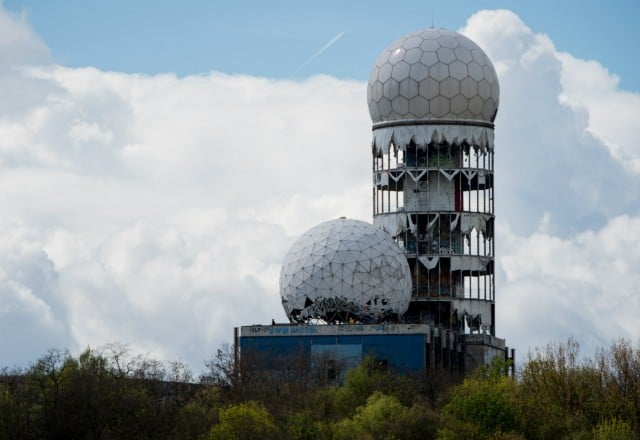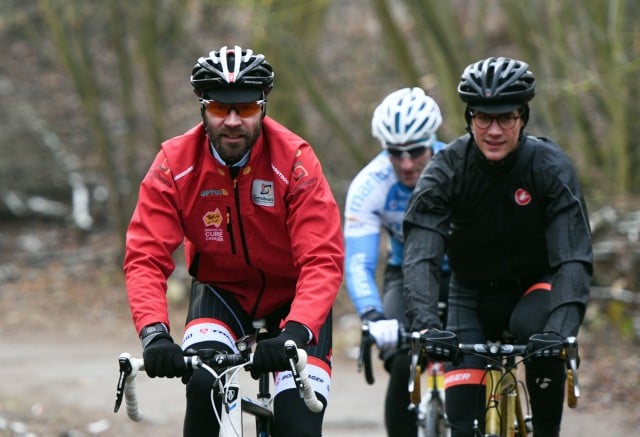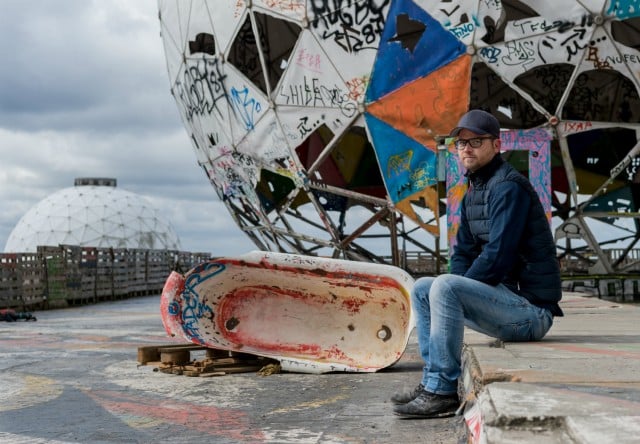10 incredible facts about the Teufelsberg spy station in Berlin

New plans have been announced to redevelop the derelict spy station at Teufelsberg in Berlin. We look back at the bizarre and secretive history of the site.
For much of the Cold War, the Americans and British used the Teufelsberg - a 120-metre hill in the west of Berlin to eavesdrop - to surveil Warsaw Pact countries.
After lying derelict for close to three decades, the hill in the Grünewald area is set to be redesigned as an artists' colony, with a museum area. The hill certainly has a rich and turbulent history to inspire future curators of the museum.
1. Built out of the ruins of war
The Teufelsberg is actually an artificial hill, made out of the rubble that Berlin was reduced to by Allied bombing during the Second World War.
For 22 years after the end of the war, up to 800 trucks a day drove the rubble out of the city and piled it up onto the area. Finally around 26 million cubic metres of rubble were stacked up, leaving a hill 120.1 metres in height.
2. Its name is misleading
The name Teufelsberg - literally devil’s hill - is very fitting for a mound built out of the ruins of war, but in fact it has nothing to do with this painful history.
The hill was actually named after the nearby Teufelssee, which is a favourite lake for those Berliners who like to bathe in the nude.
3. It was picked for its height
 Photo: DPA
Photo: DPA
The Americans and British decided to place their spy station on top of the Teufelsberg because at precisely 120.1 metres high, it was the highest elevation in West Berlin at the time.
GALLERY: Germany's oddest tourist attractions
4. It was supposed to warn of a Soviet attack
Christopher McLarren, a US army veteran who was stationed at the site during the Cold War says that “Teufelsberg was a type of forewarning post.”
“We had to gather as much information as possible in order to find out if the Soviets or the Warsaw Pact were plotting against us,” the 69-year-old, who now leads tours at the site, says.
The US documents on what type of information was collected by the NSA at Teufelsberg will only be made public in 2020.
5. 1,500 spies worked at the station
At the height of the Cold War, 1,500 spies worked on the Teufelsberg in three shifts. British and American spies were both based there, but the relationship doesn’t appear to have been totally harmonious.
“Brits and Americans were both on the Teufelsberg, but they weren’t there together,” says McLarren.
6. It was at one time a mini ski resort
Despite the fact that US and British spies were engaged in top secret work on its peak, the slopes of the hill quickly became a recreational area for West Berliners.
One million trees were planted there, turning it into an area of calm away from the city. In 1955, a ski jump was opened up on Teufelsberg, and in 1962 a bigger one was built, attracting 5,000 spectators for the opening ceremony, according to Tagesspiegel. In 1986 for the 750th anniversary of Berlin, the city held a ski race there.
To this day, there is still a climbing wall and a toboggan run on the hill.
READ ALSO: Berlin spy station sees tourism boom
7. A former pro-cyclist rode up and down the hill for 27 hours straight
 Jens Voigt cycles on the Teufelsberg. Photo: DPA
Jens Voigt cycles on the Teufelsberg. Photo: DPA
Former pro-cyclist Jens Voigt rode up and down the Teufelsberg for 27 hours without stopping in January, amassing 9,000 metres in altitude - more than the height of Mount Everest.
Voigt made his epic effort in order to raise money for a cancer charity, and claims to have amassed €25,000 in sponsorships.
8. David Lynch tried to turn it into a meditation centre
In one of the strangest chapters in the remarkable history of the hill, cult Hollywood director David Lynch tried to turn it into a “university” for the Maharishi World Peace Foundation.
The director planned for 1,000 students to study transcendental meditation and to learn yogi flying under a “tower of invincibility” on the hill.
Lynch even laid the foundation stone for the building on the hill. But the failed and surreal project is best known for his German guru Emanuel Schiffgens shouting “invincible Germany” during a 2007 press conference to introduce the project, to which someone in the crowd replied "that's what Hitler wanted."
9. Huge graffiti park
After the Cold War ended and the Warsaw Pact collapsed, Western spy agencies no longer had any need for the Teufelsberg station. So it was abandoned and fell into disrepair.
But the empty buildings have had a new coat added to their colourful history. Graffiti artists from around the globe have come to spray on its walls, turning it into the largest graffiti gallery in Europe.
10. An area of rest
 Marvin Schütte. Photo. DPA
Marvin Schütte. Photo. DPA
There are now plans to breathe fresh life into it, which tenant Marvin Schütte will present to planning authorities in Charlottenburg in the autumn.
“We don’t want any parties or high life. This should be an area where you slow down,” says Schütte, the 37-year-old real estate owner who has leased the Teufelsberg hill top.
Schütte describes his plan as the creation of a “natural cultural area.”
READ ALSO: Artist uncovers life inside US Berlin spy station
Comments
See Also
For much of the Cold War, the Americans and British used the Teufelsberg - a 120-metre hill in the west of Berlin to eavesdrop - to surveil Warsaw Pact countries.
After lying derelict for close to three decades, the hill in the Grünewald area is set to be redesigned as an artists' colony, with a museum area. The hill certainly has a rich and turbulent history to inspire future curators of the museum.
1. Built out of the ruins of war
The Teufelsberg is actually an artificial hill, made out of the rubble that Berlin was reduced to by Allied bombing during the Second World War.
For 22 years after the end of the war, up to 800 trucks a day drove the rubble out of the city and piled it up onto the area. Finally around 26 million cubic metres of rubble were stacked up, leaving a hill 120.1 metres in height.
2. Its name is misleading
The name Teufelsberg - literally devil’s hill - is very fitting for a mound built out of the ruins of war, but in fact it has nothing to do with this painful history.
The hill was actually named after the nearby Teufelssee, which is a favourite lake for those Berliners who like to bathe in the nude.
3. It was picked for its height
 Photo: DPA
Photo: DPA
The Americans and British decided to place their spy station on top of the Teufelsberg because at precisely 120.1 metres high, it was the highest elevation in West Berlin at the time.
GALLERY: Germany's oddest tourist attractions
4. It was supposed to warn of a Soviet attack
Christopher McLarren, a US army veteran who was stationed at the site during the Cold War says that “Teufelsberg was a type of forewarning post.”
“We had to gather as much information as possible in order to find out if the Soviets or the Warsaw Pact were plotting against us,” the 69-year-old, who now leads tours at the site, says.
The US documents on what type of information was collected by the NSA at Teufelsberg will only be made public in 2020.
5. 1,500 spies worked at the station
At the height of the Cold War, 1,500 spies worked on the Teufelsberg in three shifts. British and American spies were both based there, but the relationship doesn’t appear to have been totally harmonious.
“Brits and Americans were both on the Teufelsberg, but they weren’t there together,” says McLarren.
6. It was at one time a mini ski resort
Despite the fact that US and British spies were engaged in top secret work on its peak, the slopes of the hill quickly became a recreational area for West Berliners.
One million trees were planted there, turning it into an area of calm away from the city. In 1955, a ski jump was opened up on Teufelsberg, and in 1962 a bigger one was built, attracting 5,000 spectators for the opening ceremony, according to Tagesspiegel. In 1986 for the 750th anniversary of Berlin, the city held a ski race there.
To this day, there is still a climbing wall and a toboggan run on the hill.
READ ALSO: Berlin spy station sees tourism boom
7. A former pro-cyclist rode up and down the hill for 27 hours straight
 Jens Voigt cycles on the Teufelsberg. Photo: DPA
Jens Voigt cycles on the Teufelsberg. Photo: DPA
Former pro-cyclist Jens Voigt rode up and down the Teufelsberg for 27 hours without stopping in January, amassing 9,000 metres in altitude - more than the height of Mount Everest.
Voigt made his epic effort in order to raise money for a cancer charity, and claims to have amassed €25,000 in sponsorships.
8. David Lynch tried to turn it into a meditation centre
In one of the strangest chapters in the remarkable history of the hill, cult Hollywood director David Lynch tried to turn it into a “university” for the Maharishi World Peace Foundation.
The director planned for 1,000 students to study transcendental meditation and to learn yogi flying under a “tower of invincibility” on the hill.
Lynch even laid the foundation stone for the building on the hill. But the failed and surreal project is best known for his German guru Emanuel Schiffgens shouting “invincible Germany” during a 2007 press conference to introduce the project, to which someone in the crowd replied "that's what Hitler wanted."
9. Huge graffiti park
After the Cold War ended and the Warsaw Pact collapsed, Western spy agencies no longer had any need for the Teufelsberg station. So it was abandoned and fell into disrepair.
But the empty buildings have had a new coat added to their colourful history. Graffiti artists from around the globe have come to spray on its walls, turning it into the largest graffiti gallery in Europe.
10. An area of rest
 Marvin Schütte. Photo. DPA
Marvin Schütte. Photo. DPA
There are now plans to breathe fresh life into it, which tenant Marvin Schütte will present to planning authorities in Charlottenburg in the autumn.
“We don’t want any parties or high life. This should be an area where you slow down,” says Schütte, the 37-year-old real estate owner who has leased the Teufelsberg hill top.
Schütte describes his plan as the creation of a “natural cultural area.”
READ ALSO: Artist uncovers life inside US Berlin spy station

Join the conversation in our comments section below. Share your own views and experience and if you have a question or suggestion for our journalists then email us at [email protected].
Please keep comments civil, constructive and on topic – and make sure to read our terms of use before getting involved.
Please log in here to leave a comment.